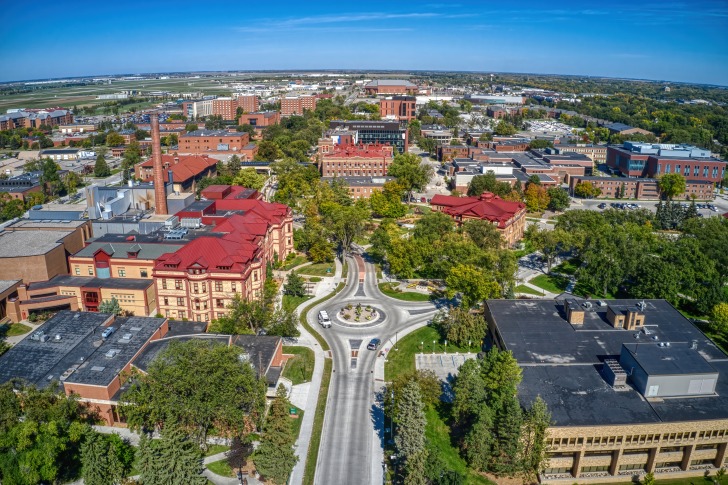North Dakota, known for its sweeping prairies, oil boomtowns, and friendly communities, offers a unique way of life. But like any state, it has places that face more challenges than others. This article explores five North Dakota cities that consistently appear on lists of the state’s “worst” places to live. It’s important to note that these lists often focus on factors like crime and economic conditions, but don’t capture the full picture of what it’s like to live there.
1. Wahpeton
- Location: Southeastern North Dakota, on the border with Minnesota.
- Reasons for its reputation:
- Low median income compared to other ND cities.
- Concerns about property crime rates.
- The other side: Wahpeton boasts a charming downtown, North Dakota State College of Science, and scenic views of the Red River. It could be a good fit for those seeking affordability and a small-town atmosphere.
2. Williston
- Location: Northwestern North Dakota, heart of the oil boom region.
- Reasons for its reputation:
- Rapid growth during the oil boom led to housing shortages and high costs of living.
- Above-average crime rates, linked to transient populations.
- The other side: While the oil boom has slowed down, Williston offers potential economic opportunities in the energy sector. It also features nearby recreation areas.
3. Devils Lake
- Location: Northeastern North Dakota.
- Reasons for its reputation:
- High property crime rates.
- Economic struggles, with some job opportunities linked to seasonal tourism.
- The other side: Devils Lake is the state’s largest natural lake, offering outdoor recreation opportunities for fishing and boating. Residents may enjoy its small-town feel and strong sense of community.
4. Minot
- Location: North-central North Dakota.
- Reasons for its reputation:
- Incidents of violent crime contribute to a higher crime rate than smaller ND cities.
- Fluctuations in the oil industry can impact the local economy.
- The other side: Minot is a regional hub with Minot State University, the North Dakota State Fair, and the Scandinavian Heritage Park, highlighting the area’s unique history.
5. Jamestown
- Location: South-central North Dakota.
- Reasons for its reputation:
- Limited economic opportunities outside of agriculture and healthcare.
- Concerns about substance abuse issues within the community.
- The other side: Jamestown boasts the National Buffalo Museum and proximity to recreation areas. Residents may enjoy the town’s affordability and slower pace of life.
Important Considerations
- Every place has pros and cons: Even cities with challenges offer positives. Factors like affordability, proximity to family, or a love for outdoor activities can make these places appealing for some.
- “Worst” is subjective: These lists are based on specific metrics. Individuals might prioritize different things like school quality, cultural amenities, or career opportunities when deciding where to live.
- Change is constant: North Dakota communities are evolving. Economic conditions, local initiatives, and population shifts can all influence a place over time.
Sources
- [Money Inc.: The Worst Places to Live in North Dakota] ([invalid URL removed])
- [US 103.3: Are You Slummin’ It? 5 Worst Places To Live In North Dakota] (https://us1033.com/are-you-slummin-it-5-worst-places-to-live-in-north-dakota/)
- Only in Your State: 10 Most Dangerous Cities in North Dakota: https://www.onlyinyourstate.com/north-dakota/dangerous-cities-nd/
- FBI Uniform Crime Reporting Program: [https://ucr.fbi.gov/]
- North Dakota Department of Commerce: [https://www.commerce.nd.gov/]
Conclusion
Choosing where to live is a personal decision. While some North Dakota cities face challenges, it’s essential to look beyond the labels and statistics.
Beyond the Numbers: Understanding Life in These Cities
While statistics provide a starting point, it’s important to understand the lived experiences of people in these communities. Here are a few additional factors to consider:
- Community Resilience: Even towns facing economic hardship or higher crime rates often have residents actively working to improve their situation. Look for stories of community organizations, volunteer initiatives, and local revitalization efforts.
- Cost of Living: “Worst” places might have more affordable housing and lower living expenses compared to larger North Dakota cities. This could be a major advantage for those on a budget or wanting to own a home.
- Job Market Dynamics: While some cities experience limited overall job opportunities, they might excel in certain sectors. Research specific industries thriving in a town that might match your skillset.
- Outdoor Recreation: Many of these towns offer fantastic access to hunting, fishing, hiking, or lakeside activities. If you love the outdoors, this could be a significant quality of life factor.
Finding the Right Fit
Here are questions to help anyone considering a move to these cities, or any town in North Dakota:
- What are my priorities? Do you value low housing costs, job opportunities in a particular field, proximity to natural beauty, or a specific type of community environment?
- Am I willing to trade off? Smaller or less prosperous towns may offer affordability or a slower pace but lack some amenities found in larger cities.
- How do I define “quality of life?” Does this mean cultural events, a thriving social scene, or does it revolve around family, affordability, and access to the outdoors?
A Note of Perspective
North Dakota is a state full of welcoming people, breathtaking natural beauty, and a unique cultural identity. Even cities with challenges have their own strengths and potential. It’s essential to avoid overly negative stereotypes and remember that every place offers something unique. Before making a judgment, dig deeper, research specific aspects that matter to you, and, if possible, visit these towns yourself to experience them firsthand.



